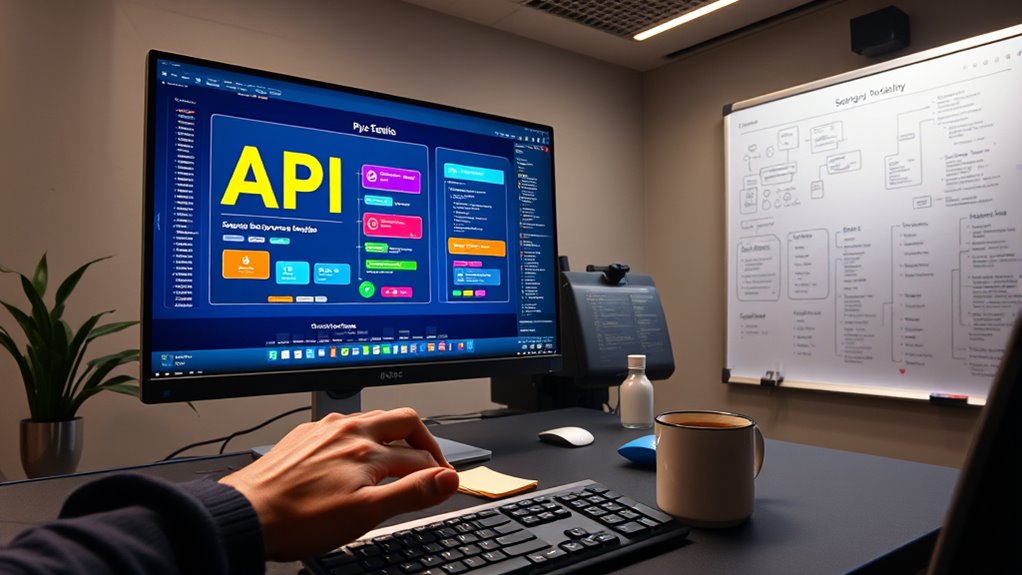To build a SaaS platform with API monetization, focus on forming strategic partnerships that complement your offerings and create value for both sides. Design clear, reliable APIs with thorough documentation and sandbox environments to encourage third-party integrations. Engage users through tutorials, support, and community-building strategies. Regularly analyze usage patterns to optimize features, and develop flexible pricing models. If you want to discover how to grow your ecosystem and maximize revenue, keep exploring these key strategies further.
Key Takeaways
- Design scalable, well-structured APIs with comprehensive documentation to facilitate easy integration and adoption.
- Develop strategic partnerships and incentives to grow the ecosystem and encourage third-party API usage.
- Implement tiered access and flexible pricing models to monetize API usage effectively.
- Use analytics to monitor API performance, user behavior, and optimize offerings accordingly.
- Foster user engagement through tutorials, community support, and continuous feature improvements to drive platform loyalty.

In today’s competitive digital landscape, a SaaS platform with API monetization offers businesses a powerful way to generate revenue and expand their reach. By opening your platform through well-designed APIs, you create opportunities for third-party developers and partners to integrate your services into their applications. This approach relies heavily on effective Partnership Strategies, where you build relationships that foster mutual growth. You should focus on identifying potential partners whose offerings complement your platform, then create incentives for them to adopt your APIs. Clear documentation, developer support, and flexible onboarding processes are essential in strengthening these partnerships. When you nurture these relationships, you not only increase your platform’s usage but also establish a broader ecosystem that benefits all parties involved.
To succeed, you need to develop User Engagement Tactics that encourage developers and users to actively utilize your APIs. Offering extensive, easy-to-understand documentation and interactive tutorials helps reduce onboarding friction. Consider implementing sandbox environments where developers can experiment with your APIs without risks, making it easier for them to see the value your platform provides. Regular communication, such as newsletters or developer forums, keeps your community engaged and informed about new features or updates. Gamification elements, like badges or recognition programs, can also motivate ongoing engagement and foster a sense of community around your API offerings. Additionally, understanding the importance of API performance and reliability ensures that your services meet user expectations and build trust in your platform.
Develop engaging tutorials, sandbox environments, and community communication to boost API user adoption and loyalty.
Moreover, monitoring how users interact with your APIs allows you to refine your engagement strategies. Analytics tools can provide insights into API usage patterns, helping you identify popular features or areas where users struggle. Use this data to improve your documentation, add new features, or simplify existing processes. Offering tiered access levels or flexible pricing models can cater to different user needs, encouraging more extensive adoption. Remember, the goal is to make your API indispensable to your user base, which requires ongoing support, updates, and responsiveness to feedback.
Ultimately, integrating strong Partnership Strategies with effective User Engagement Tactics creates a self-reinforcing cycle that fuels your platform’s growth. As your partners and users see tangible value and feel supported, their loyalty and usage increase, leading to more revenue streams and greater market presence. Building a SaaS platform with API monetization isn’t just about technical infrastructure; it’s about cultivating relationships and delivering ongoing value that keeps your ecosystem vibrant and expanding.
Frequently Asked Questions
How Do I Choose the Right API Monetization Model?
You choose the right API monetization model by considering your target users and their needs. Start with clear API pricing that aligns with your value offering. Focus on streamlining user onboarding so customers can easily access features. Test different models like usage-based or tiered plans, then analyze feedback and usage data to refine your approach. The best model balances revenue with customer satisfaction, ensuring sustainable growth.
What Security Measures Are Essential for API Monetization?
You need to implement strong security measures like data encryption to protect sensitive information and user authentication to verify users before granting access. Use HTTPS to secure data in transit and encrypt stored data to prevent breaches. Regularly update security protocols, monitor API activity for suspicious behavior, and employ OAuth or API keys for controlled access. These steps make certain your API remains secure and trustworthy for users.
How Do I Handle API Versioning and Updates?
You should implement clear version management by using semantic versioning and maintaining multiple API versions if necessary. Communicate upcoming updates through documentation and changelogs. Use update strategies like deprecation notices and backward compatibility to minimize disruption. You can also offer support for older versions during progression periods, ensuring smooth updates. Regularly monitor and plan your versioning to keep your API reliable, secure, and user-friendly.
What Are Common Challenges in Saas API Monetization?
You’ll face challenges like choosing effective pricing strategies that appeal to different customer segments. Balancing value and affordability can be tricky, and you might struggle to prevent API abuse or manage usage limits. Additionally, understanding customer segmentation helps tailor plans, but it requires ongoing analysis. Ensuring seamless onboarding and support while maintaining profitability is critical. These hurdles demand continuous refinement of your monetization approach to sustain growth and customer satisfaction.
How Can I Optimize API Usage and Revenue?
To optimize your API usage and revenue, leverage API analytics to identify high-value features and user behaviors. Implement usage throttling to prevent abuse and guarantee fair access, which maintains system stability. You should also experiment with tiered pricing based on usage patterns, encouraging higher consumption from premium users. Regularly analyze data to refine your strategies, ensuring you’re maximizing revenue while providing an excellent user experience.
Conclusion
Building a SaaS platform with API monetization is like planting a seed that grows into a flourishing tree—your revenue streams branch out and thrive. By focusing on seamless integration, clear pricing, and customer value, you’ll nurture a sustainable business. Remember, the key is to keep innovating and listening to your users. With dedication, your platform can blossom into a thriving ecosystem, turning every API call into a fruitful harvest.








